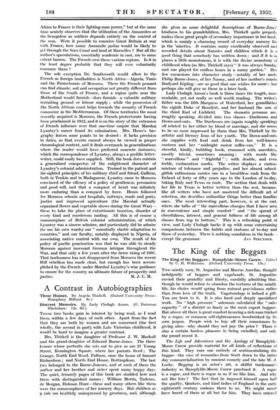A Contrast in Autobiographies
Tuasn two books gain in interest by being read, as I read thorn, within a few days of each other. Apart from the fact that they are both by women and are concerned (the first wholly, the second in part) with Late Victorian childhood, it would be hard to imagine a greater contrast.
Mrs. Thirkell is the daughter of Professor J. W. Mackail and the grand-daughter of Edward Borne-Jones. The three houses whose portraits she sets out to give us are 27 Young Street, Kensington Square, where her parents lived ; The Grange, North End Road, Fulham, once the home of Samuel Richardson ; and North End House, Rottingdean. The last two belonged to the Bume-Joneses, and at each of them the author and her brother and sister spent many happy days The quiet, leisurely pages of this book are studded here and there with distinguished names : William Morris, Tadema, de Morgan, Holman Hunt—these and many others like them Were the commonplaces of her nursery days. But children as rule are healthily unimpressed by greatness, and, although she gives us some delightful descriptions of flume-Jones' kindness to his grandchildren, Mrs. Thirkell quite properly makes these great people of secondary importance in her book, which is mainly a charming record of everyday nursery life in the 'nineties. It contains many excellently observed and recorded details about Nannies and children which it is it good thing that somebody has written down ; and if it is in places a little monotonous, it is with the divine monotony of childhood when (as Mrs. Thirkell says) "it was always Sunday and one played for endless hours in a sunny garden." Her few excursions into character study—notably of her uncle Philip Borne-Jones, of her Nanny, and of her mother's cousin Rudyard Kipling—are so good that one wishes for more : but perhaps she will give us those in a later book.
Lady Clodagh Anson's book is three times the length, more readable, yet not really so well worth reading. The writer's father was the fifth Marquess of Waterford, her grandfather the eighth Duke of Beaufort, and her husband the son of
the third Earl of Lichfield. The dramatis personae are, roughly speaking, divided into two classes—Duchesses and Down-and-outs. The Duchesses are (again roughly speaking) all related to her either by blood or marriage, and she seems to be no more impressed by them than Mrs. Thirkell by the artistic and literary lions of her youth. The Down-and-outs she supplies with food and drink from her well-known canteen and her "midnight motor coffee-van." It is a cheerful, kindly, bubbling book, crammed with anecdotes, mostly trivial, sometimes amusing ; with words like "marvellous" and " frightful " ; with double, and even treble, exclamation marks. The writer displays a curious mixture of tolerance and prejudice, and her almost school- girlish enthusiasm carries one in a breathless rush from the Ireland of forty or fifty years ago to the London of to-day, taking Italy and Texas en route. The section that deals with her life in Texas is better written than the rest, because, like all writers who have not mastered the difficult art of selection, she describes unfamiliar things better than familiar ones. The most interesting part, however, is at the end, where she talks of "the marvellous changes that I have seen in convenience and simple comfort" and "the spread of cheerfulness, interest, and general fullness of life among all classes from top to bottom." This- is a refreshing point of view, and Lady Cloriagh backs it up with some entertaining comparisons between the habits and customs of to-day and those of yesterday. There is nothing scandalous in the book—








































 Previous page
Previous page